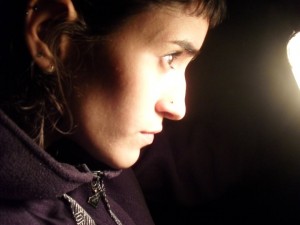
Lucía Ferreira
In one of his most revered poems, Longfellow described the flight of song as something too strong and too constant to be followed by the human eye. If we were to dig deeper into what is implied in that frequently-anthologized lay (what the heck, Gil Grissom actually recites it in one chapter of CSI), we would have to agree that the only point of origin for something which is indeed strong and constant has to be an artist that meets these very two aptitudes. And you can say what you want about Uruguayan artists, but more than a very representative number of performers here certainly shine when it comes to strength, and excel as far as constancy is concerned. The one I would like to tell you a little about now certainly does.
She is named Lucía Ferreira, and during her artistic life she has been part of duets (“No Es Mi Mujer”) [She Is Not My Woman], murgas (“La Japilong”), rock & roll bands (“Vía Libre”) [Free Way]… she is currently playing with Julio Ojeda. Any artist that has treaded so much ground in less than 30 years is not only a well-nurtured one. To all intents and purposes, such an artist is the one who is nurturing to others.
The songs she is currently working on often touch on issues such as self search and the validation of one’s place in the world (that is the thematic denominator of both “Diván” [Couch] and “Me Quiero Quedar” [I Want To Stay]), and the role that art has a mediator between the world that there is and the world that there should be is incarnated in songs like “Vieja Viola” [Old Six-string]. In the song (a tango written by luminary Humberto Correa), an old performer can but look into his former source of pride (his guitar) from a yearning stance that paints a savage contrast with the humdrum of the domesticity he has sunk into. The corollary is that an artist is always a seeker of something else in life, even if that implies that to let others find that something he will have to renounce to his ability to hold onto these things that he has found along the way. Lucía does the song very well, as she has all the necessary vocal chops to convey the world-weariness of the lyrics, if only because a voice that has been tempered by so many styles becomes malleable in itself.
And I particulary like the song “Cajones Del Alma” [Drawers Of The Soul], a song that reminds me of the Jam’s “No-one In The World” – a tale of longing for an existence that is fated not to return, no matter how much the singer make-believes.
In Longfellow’s poem, the fate of the song that is breathed into the air is revealed in the final stanza: “And the song, from beginning to end/I found again in the heart of a friend”. That is the joy of music. It bonds you instantly with others. Magdalena Martínez (a Spanish flute player) once termed music as “the most direct artistic manifestation…it gets in through your ear, and it goes straight into your heart”. And when the music you are listening to is the result of so much experience and constancy, it also nestles in your soul. And that is the true moral of the story of so many unsigned artists here in Uruguay.
This is Lucía’s MySpace profile.

Pingback: MusicKO: Uruguayan Unsigned & Independent Artists Of 2010 | MusicKO